Fixing Marks & Spencer
- Published
- comments
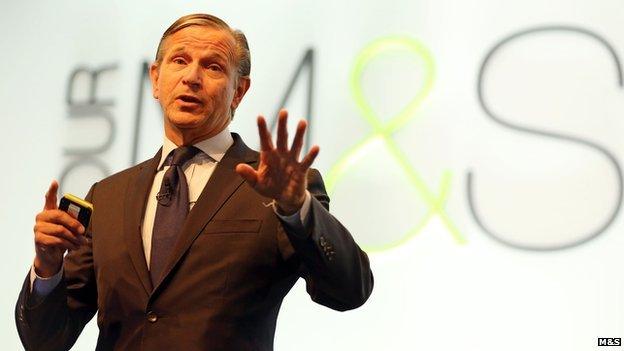
The story of the plain, black ballet pump is forever etched on Marc Bolland's memory.
In 2012 the chief executive of one of Britain's oldest High Street retailers admitted that Marks & Spencer could have sold more of the fashion item of the moment, if only if it had more supply.
In retail, that's like admitting that you could have sold more tights or bananas or tables if only the staff had remembered to open the shops at the right time every morning.
Never, ever leave your customers looking at empty shelves when their purses and wallets are open.
The black ballet pump miss seemed to sum up everything that was wrong at M&S. Even when the store picked a fashion hit - and for many in the fashion world that simply wasn't regularly enough - it still managed to mess it up.
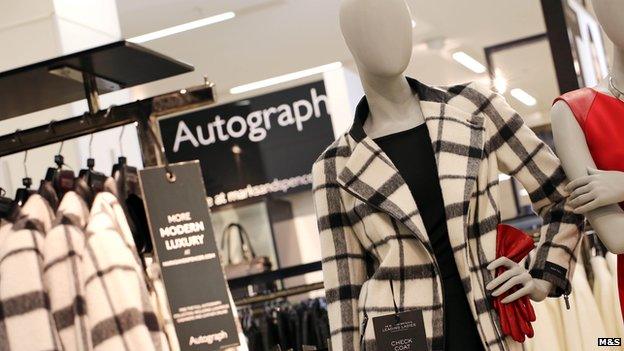
Total sales of UK clothing that year were down 0.3% (it also had problems with popular knitted jumpers). I remember talking to one board member at the time who expressed astonishment that he couldn't find a suit in his size at his local M&S.
For the last decade M&S has struggled with a host of legacy issues, of which an over-complicated supply line was just one.
Dowdy stores characterised by endless racks of "black slacks" had turned customers off, the quality of the clothing was described as "variable", it had too many sub-brands which confused shoppers, price-cutting promotions - which hit profit margins - were used like a drug to shore up faltering sales, a clunky online site (based on an old off-the-shelf Amazon model not built for the modern world of retail online) was an irritant, the success of food was not replicated across clothing or homeware.
Marks & Spencer was not clear on whether it was fighting new arrivals Primark and New Look - appealing to a younger, highly price sensitive audience - or John Lewis. It appeared to have forgotten that its average shopper was over 50, not 18.
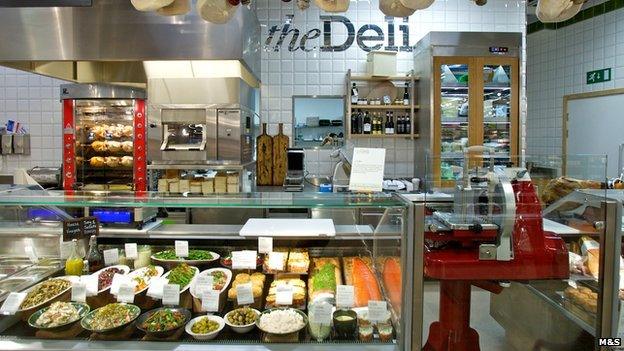
Food sales have been a success story for the company
On Wednesday, M&S will reveal its half-year results. Profits are likely to be down and sales flat or falling. But step back, those close to Mr Bolland insist, and there is evidence that the tanker is turning around.
For the first time allies of Mr Bolland say that the former chief executive of Morrisons now believes he has a shop close to his vision of what M&S should be.
Some of that vision was unveiled at a glittering launch of its new upmarket store in the Westfield shopping centre in west London on Monday night. There Mr Bolland rubbed shoulders with analysts and journalists, threw his arms wide and said - this is what we want to offer customers.
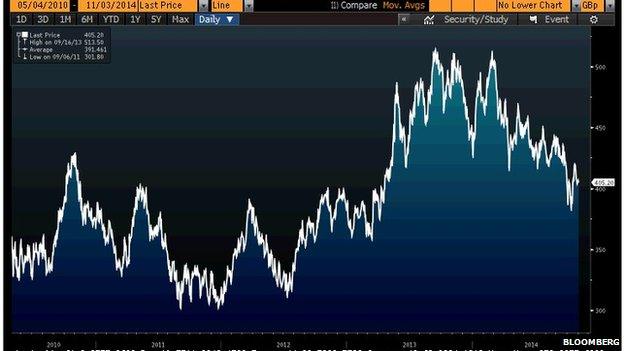
M&S's share price rose steadily from mid-2012 but has dropped this year
With a share price that has fallen 15% this year, M&S has tested investors' patience, a fact Mr Bolland alluded to at M&S's new "deli bar" at the heart of the shop.
"You have been patient with me because I always say step by step, and it will always be step by step," Mr Bolland said. He told me as we looked around the store that turning around a brand takes at least five years.
The new store has a nail bar, a baby department, men's tailoring and fewer clothing sub-brands. By the way, 70% of all menswear purchased in an M&S store is bought by women - they are the key shopper.

The retailer has been working on improving its branding
The brute amount of clothes on sale has been reduced by 10% to allow for more space, tackling the long term "black-slack" problem neatly summed up Patrick Bousquet-Chavanne, director of marketing for M&S, who said that customers complained that "too much was being thrown at them".
The shop branding has also been revamped so that it matches the feel of food, online and television advertising. Remarkably, Mr Bolland admitted that this was the first time M&S could be seen as a "one channel" retailer in its 130-year history.
And, for investors - who might stomach falling like-for-like sales as long as profit margins are protected - there was one vital thing not on show. In the whole store there was not a whiff of promotion anywhere, no sale items, no screaming money-off offers and no two-for-one offers.
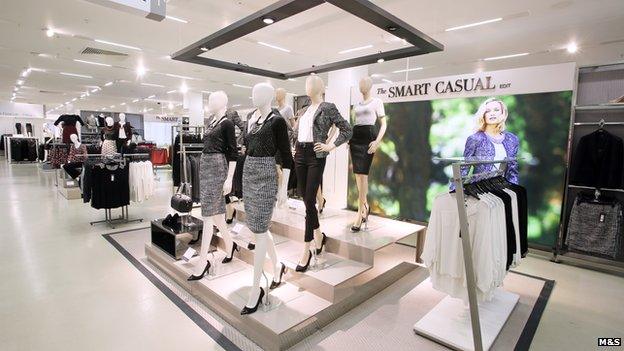
In its last update in June, M&S did show a marked improvement in women's wear
Customers, investors and analysts will be clearer now on where M&S is going - John Lewis at mid-market prices.
The problem is, the new M&S will only be wholly available in 70 of M&S's flagship stores. The rest of the 350 store estate will show "elements" of the new look but they are simply not large enough to handle the full makeover.
And this goes to the heart of M&S's relationship with its customers, who have complained that the most popular items - like last year's pink overcoat - are too limited "limited editions".
Jamie Merriman, retail analyst at Bernstein Research, often holds focus groups of M&S shoppers. They tell her that the standard of shops is too variable and that many are still cluttered and unappealing places to be.
"There is room for improvement," Ms Merriman says diplomatically. And improvement means expenditure, which can mean a weaker bottom line.
Store wars
Key M&S figures
0.6% fall
in clothing sales 3 months to June 2014
1.7% rise
in food sales 3 months to June 2014
-
8.1% fall in trading on marksandspencer.com following re-launch
-
4.7% rise in international sales
-
150 Simply Food stores opening over next 3 years
What is that bottom line likely to look like? Three figures are vital tomorrow.
The first is clothing. In June M&S announced clothing like-for-like sales down by 0.6%, although there was a marked improvement in women's wear.
A warm autumn is likely to maintain that downward pressure, straining Mr Bolland's pledge that gross margins will improve.
Those close to him say that the results have to be considered in the light of a very tough market. Next and H&M have already reported slower sales growth.
Second comes food, a success story for M&S. Has the retailer maintained the momentum of the summer when it announced that sales were up 1.7%?
Third is online. M&S re-launched its website earlier this year, a move which saw a significant drop in activity as customers had to migrate and "re-join" the new website. To some criticism, M&S refused to spend money on marketing, saying it wanted time for the new site to bed in.
In June the retailer announced sales on marksandspencer.com were down a stomach lurching 8%. Investors will be looking for marked signs of improvement.

M&S has a wide range of pink coats in its winter collection this year
Mr Bolland took over M&S in 2009, external and those around him say that turning around the retailer has been tougher than he thought. There have been mis-steps on range availability, chasing the wrong low-end markets and reaching for the drug of price-cutting promotions too readily.
Some analysts believe if M&S's sales figures do not turn markedly positive in the next 12 months, pressure will grow on the board to find a replacement at the top. Analysts have been saying that for a while, but Mr Bolland has so far done enough to keep the wolves from the door.
Mr Bolland insists that all the pieces are in place (although investors might argue it has taken him an awful long time to get there). It is now all about execution, he says, and ensuring that M&S can take advantage of an improving UK economy.
That, and making sure there are enough ballet pumps on the shelves. And pink coats on the racks.